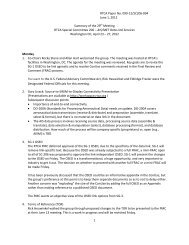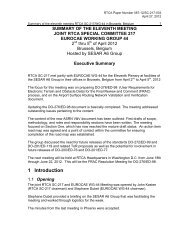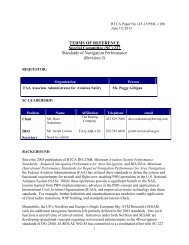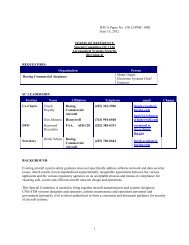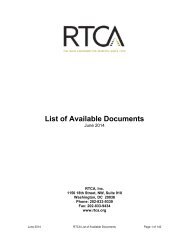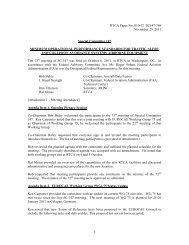SC-226 MEETING MINUTES Working Group JANUARY 14 ... - RTCA
SC-226 MEETING MINUTES Working Group JANUARY 14 ... - RTCA
SC-226 MEETING MINUTES Working Group JANUARY 14 ... - RTCA
You also want an ePaper? Increase the reach of your titles
YUMPU automatically turns print PDFs into web optimized ePapers that Google loves.
<strong>RTCA</strong> Paper No. 021-13/<strong>SC</strong><strong>226</strong>-010<br />
February 6, 2013<br />
<strong>SC</strong><strong>226</strong> committee response:<br />
The oxygen mask working group should also consider the EASA deviation request related to frequency<br />
response modification from the current DO-2<strong>14</strong> standard requirements.<br />
Seventh item of discussion: Discussion “HOT MIC” definition within the standard, Michel Colin, Airbus<br />
Michel noted that the standard should define the term “HOT MIC” (e.g. the MIC to CVR audio path<br />
through the audio system).<br />
The ED112 definition can be used.<br />
Michel Collin, Airbus, submitted the following language originating from ED112:<br />
Hereunder the definition of Hot-mic from ED 56A:<br />
The CVR 'HOT' Microphone:<br />
The hot-microphone ensures that, in addition to the recording of the radio transmissions to and from the aircraft,<br />
all sounds received by the crew's microphones are recorded continuously irrespective of the position of the audio<br />
selector switches. The volume control has no effect on the level of recording of the hot-microphone. A minor<br />
interface change provides the hot-microphone feature by summing each crew member's microphone signal with<br />
the telephone signal.<br />
The CVR itself is not affected by implementation of this concept.<br />
And a precision given by ED 112:<br />
Each CVR should be installed so as to provide with reference to a timescale, simultaneous recordings of:<br />
i. voice communications transmitted from or received in the cockpit by radio,<br />
ii. the aural environment of the cockpit,<br />
iii. the audio signals received from each boom and mask microphone in use, without interruption,<br />
8th item of discussion: Audio Noise Without Signal and Listening Test during DO-160x Section 8<br />
vibration.<br />
Todd Blackstock, AEM, pointed out that DO-<strong>14</strong>3 for Marker Beacons allows a relaxed noise requirement<br />
during vibration. Additional vibration test data taken from a system tested by Cobham determined that<br />
at some resonant frequencies, noise levels during vibration can reach 30 dB below rated power.<br />
Honeywell also reviewed their test data and confirmed similar results from testing they had performed.<br />
For audio systems, a noise and listening test should be included because problems with noise have been<br />
observed, such as due to microphonics. The noise level can similarly be relaxed from the 50 dB below<br />
rated power requirement from Section 2.4 because the ambient acoustic noise background is also<br />
elevated during the test, and during normal operation of the system in its operating environment. Thus<br />
Page 7 of 20




